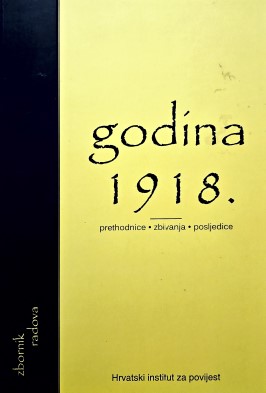Guske u magli - Djelovanje članova Središnjega odbora Narodnoga vijeća Slovenaca, Hrvata i Srba u Zagrebu (listopad 1918.–siječanj 1919.)
Geese in the Fog: The Activity of the Members of the Central Committee of the National Council of Slovenes, Croats, and Serbs in Zagreb (October 1918 – January 1919)
Author(s): Zlatko Matijević
Subject(s): Political history, Government/Political systems, Political behavior, Comparative politics, Pre-WW I & WW I (1900 -1919)
Published by: Hrvatski institut za povijest
Keywords: Austro-Hungarian Monarchy; First World War; National Council of Slovenes Croats and Serbs; Central Committee of the National Council of Slovenes Croats and Serbs; State of Slovenes Croats and Serbs
Summary/Abstract: The justified dissatisfaction of the Slovene political elite with the situation of their lands in the Austrian half of the state, the bitterness of the Croat politicians regarding the dualistic arrangement of the state, which led to the separation of Banal Croatia from Dalmatia and the constitutionally unclear status of Bosnia and Hercegovina, grew into problems which would significantly con-tribute to the ultimate dissolution of the Austro-Hungarian Monarchy. This atmosphere gave rise to the demand to unite the Croats, Slovenes, and Serbs, “three tribes of one nation,” in a common state. The inaugural meeting of the National Council of Slovenes, Croats, and Serbs (Narodno vijeće Slovenaca, Hrvata, i Srba – NV SHS) was held in Zagreb on 5 and 6 October 1918. After a short hesitation, the Croat-Serb Coalition, the ruling group in Banal Croatia, joined the ranks of the NV SHS. On 19 October 1918, the Central Committee of the NV SHS openly declared its demand for the “unification of the whole nation of Slovenes, Croats, and Serbs on the entirety of its ethnographic territory,” without regard to regional or state boundaries, within “one united and fully sovereign state.” At the meeting of the Central Committee on 28/29 October 1918, the propositions of Svetozar Pribićević to sever all constitutional ties between the Kingdom of Croatia-Slavonia and Dalmatia and the Kingdom of Hungary and the Austrian Empire and of Ante Pavelić (Senr.) regarding the resolution of the Croatian Sabor (Parliament) to recognize the NV SHS as the “supreme government” were adopted. On 29 October 1918, the Croatian Sabor accepted both of these propositions. It was not the goal of the members of the Central Committee to create an independent State of Slovenes, Croats, and Serbs outside of the boundaries of the Monarchy, but rather to quickly unite their lands with the Kingdom of Serbia and the Kingdom of Montenegro in a new common state. Soon after the unification of the State of Slovenes, Croats, and Serbs with the Kingdom of Serbia was announced on 1 December 1918, the NV SHS and all of its components lost their raison d’être.
Book: Godina 1918. Prethodnice, zbivanja, posljedice
- Page Range: 105-128
- Page Count: 24
- Publication Year: 2010
- Language: Croatian
- Content File-PDF

